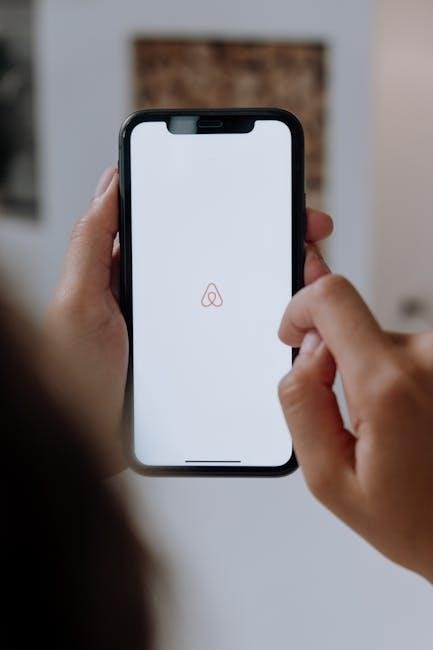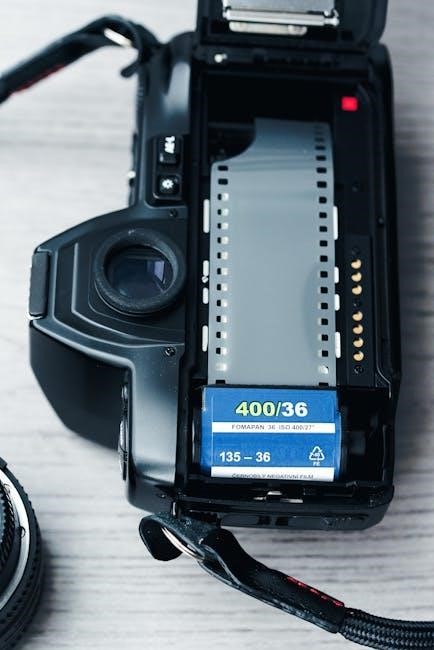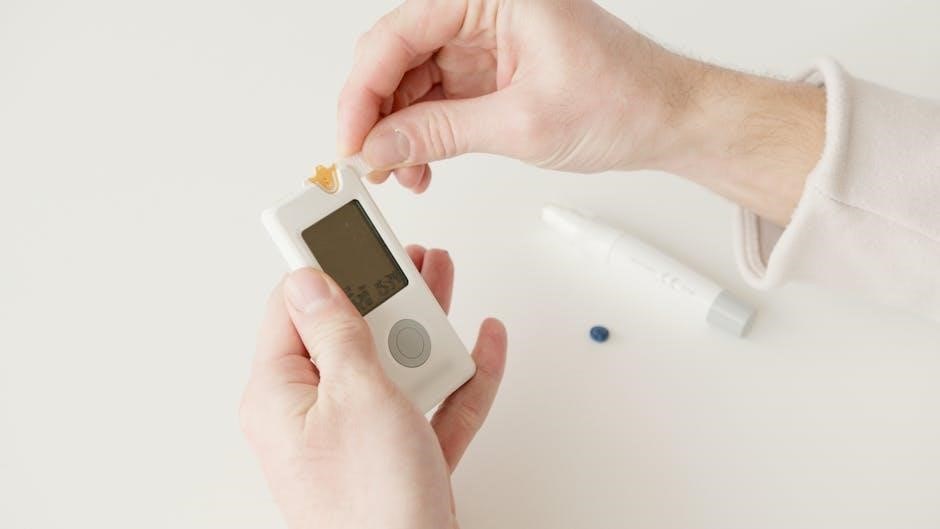Welcome to the Sensaphone 400 User Manual, your comprehensive guide to understanding and utilizing the Sensaphone 400 monitoring system. This manual provides detailed instructions, setup procedures, and troubleshooting tips to ensure optimal performance and customization of your device. Designed for both beginners and advanced users, it covers all aspects of the system, from installation to advanced monitoring features. Use this manual to unlock the full potential of your Sensaphone 400 and maintain reliable environmental monitoring.
Overview of the Sensaphone 400 Monitoring System
The Sensaphone 400 is a comprehensive monitoring system designed to track environmental conditions such as temperature, humidity, and water presence. It offers real-time data collection and remote monitoring capabilities, ensuring users stay informed about critical changes. With four external inputs, the system allows connection to various sensors, providing alerts for predefined thresholds. Its nonvolatile memory and 24-hour battery backup enhance reliability. Ideal for homeowners, business owners, and property managers, the Sensaphone 400 is versatile and customizable, making it suitable for diverse applications. This system is a robust solution for maintaining environmental control and receiving instant notifications to prevent potential damages or disruptions.
Importance of Reading the User Manual
Reading the Sensaphone 400 User Manual is essential for understanding the system’s features, proper setup, and troubleshooting. It provides step-by-step instructions for installation, configuration, and operation, ensuring optimal performance. The manual explains how to connect sensors, customize alerts, and utilize remote access features effectively. It also offers guidance on routine maintenance and updating firmware, which are critical for long-term reliability. By following the manual, users can avoid common issues and ensure their monitoring system functions as intended. This guide empowers users to maximize the device’s potential, safeguarding their property and assets through accurate and timely environmental monitoring.

Installation and Setup of the Sensaphone 400
Install the Sensaphone 400 by following the manual’s step-by-step guide. Mount the device, connect sensors, and configure network settings for seamless monitoring and alerts.
Physical Installation of the Device
Begin by selecting a suitable location for the Sensaphone 400, ensuring it is centrally positioned for optimal monitoring. Mount the device securely on a wall or place it on a flat surface. Use the provided mounting hardware to ensure stability. Connect the power supply and ensure all cables are neatly organized. Avoid exposing the device to direct sunlight or moisture. Once mounted, proceed to connect sensors and inputs as outlined in the next section. Proper physical installation is crucial for reliable performance and accurate monitoring. Refer to the manual for specific diagrams and mounting recommendations.
Connecting Sensors and Inputs
The Sensaphone 400 supports up to four external inputs, allowing you to connect a variety of sensors for monitoring temperature, humidity, water detection, and more. Begin by identifying the appropriate sensor for your needs and ensure it is compatible with the device. Connect each sensor to the designated input ports on the rear of the unit. Use the provided or recommended cables to ensure secure connections. Once connected, configure the device to recognize each sensor through the setup menu. Refer to the manual for specific wiring diagrams and configuration instructions. Properly connected sensors are essential for accurate monitoring and reliable alerts. Always test connections to ensure functionality before finalizing the setup.
Network Configuration and Connectivity
To ensure reliable monitoring, configure the Sensaphone 400’s network settings properly. Connect the device to your local network using an Ethernet cable for a stable connection. For wireless setups, enter your Wi-Fi credentials in the device’s configuration menu. Assign a static IP address to the Sensaphone 400 for consistent remote access. Ensure port forwarding is set up on your router to allow incoming connections. Verify network settings by accessing the device through its web interface. If issues arise, check your network configuration and ensure all settings are accurate. Proper network setup is crucial for remote monitoring and receiving alerts. Follow the manual’s guidelines to establish a secure and reliable connection.

Features of the Sensaphone 400
The Sensaphone 400 offers advanced monitoring capabilities, including temperature, humidity, and water detection. It provides real-time alerts, remote access via web and mobile, and supports up to four external sensors for comprehensive environmental control.
Temperature Monitoring and Alerts
The Sensaphone 400 excels in temperature monitoring, ensuring precise detection of environmental changes. It offers customizable temperature ranges and alerts, notifying users via SMS, email, or phone when thresholds are breached. With real-time data access, you can monitor conditions remotely, ensuring timely interventions. The system’s nonvolatile memory retains settings during power outages, and a 24-hour battery backup guarantees continuous operation. Additionally, it integrates with dual setback thermostats for remote temperature adjustments, making it ideal for critical applications like cold storage and laboratories. This feature-rich monitoring ensures your environment remains stable and secure, minimizing potential damage from temperature fluctuations.
Humidity and Water Detection Capabilities

The Sensaphone 400 also features advanced humidity and water detection capabilities, ensuring comprehensive environmental monitoring. It allows users to connect sensors that detect excessive humidity levels or water presence, preventing potential damage from mold or leaks. Customizable alerts notify you immediately when humidity levels fall outside a set range or water is detected, enabling quick action. With real-time monitoring, you can track conditions remotely and receive notifications via SMS, email, or phone calls. This dual-functionality enhances the system’s versatility, making it ideal for applications requiring both temperature and humidity control, such as laboratories, storage facilities, and residential properties. The system ensures peace of mind by guarding against environmental risks.
Remote Access and Control Features
The Sensaphone 400 offers robust remote access and control capabilities, allowing users to monitor and manage their system from anywhere. Through its web interface or mobile app, you can view real-time data, adjust settings, and receive instant notifications. Remote access ensures you stay informed about environmental conditions, even when you’re not on-site. The system also supports remote control of connected devices, such as thermostats or alarms, enabling you to take action promptly. With secure and reliable connectivity, the Sensaphone 400 provides unparalleled convenience and peace of mind, making it ideal for managing remote properties or critical facilities effectively.

Using the Sensaphone 400
The Sensaphone 400 is designed for ease of use, with intuitive navigation and clear controls. Users can quickly access monitoring data, adjust settings, and perform routine tasks efficiently.
Basic Operations and Navigation
Mastering basic operations of the Sensaphone 400 ensures smooth monitoring and control. Begin by powering on the device and navigating through the intuitive menu system. Use the keypad or touchscreen to access settings, view real-time data, and perform essential tasks. The interface is designed for ease of use, with clear labels and logical categorization of functions. Familiarize yourself with the home screen, which displays critical information such as temperature, humidity, and system status. Learn to toggle between menus, adjust parameters, and review historical data. Understanding these fundamental operations will enhance your ability to monitor and respond to environmental changes effectively. Regular practice will make navigation second nature.
Setting Up and Customizing Alerts
Setting up and customizing alerts on the Sensaphone 400 is essential for proactive monitoring. Begin by defining threshold levels for temperature, humidity, and other sensors. Navigate to the alert settings menu and select the parameters you wish to monitor. Choose notification methods such as SMS, email, or phone calls, and assign contacts for each alert type. Customize the sensitivity of alerts to minimize false notifications and ensure timely responses. Use the system’s built-in templates or create custom scenarios to suit your needs. Regularly test your alert configurations to confirm reliability. Adjustments can be made at any time to refine alert triggers and notification preferences, ensuring seamless monitoring and peace of mind.
Advanced Functions for Monitoring
The Sensaphone 400 offers advanced monitoring functions to enhance your environmental control. Utilize remote access via the web interface or mobile app to monitor conditions in real-time. Customize monitoring parameters, such as temperature ranges and humidity levels, to suit specific needs. Set up multiple alert tiers for critical and non-critical events, ensuring timely responses. Leverage data logging to track historical trends and identify patterns. The system also supports integration with external devices, allowing for automated responses to alerts, such as activating a thermostat or alarm. With these advanced features, you can optimize monitoring for sensitive environments, ensuring maximum protection and efficiency in your operations.

Customization and Configuration
The Sensaphone 400 allows users to tailor monitoring settings to specific needs. Adjust sensor sensitivity, set custom alerts, and define notification preferences for personalized environmental control and peace of mind.
Configuring Sensors and Inputs
Configuring sensors and inputs on the Sensaphone 400 is straightforward. Connect up to four external sensors to monitor temperature, humidity, water presence, and more. Follow the manual’s step-by-step guide to ensure proper installation and calibration. Assign each sensor to a specific input channel, enabling tailored alerts and monitoring. Use the device’s interface or remote access to set thresholds and sensitivity levels. This customization ensures accurate and reliable data collection, allowing you to respond promptly to environmental changes. Proper configuration is key to maximizing the system’s effectiveness in safeguarding your property and assets.
Setting Up Notification Preferences
Setting up notification preferences on the Sensaphone 400 allows you to customize how you receive alerts. Choose from multiple notification methods, including email, SMS, or phone calls. Define specific conditions for when alerts should be triggered, such as temperature thresholds or water detection. You can also set up notification schedules to ensure alerts are sent only during desired times. Additionally, configure escalation protocols to notify secondary contacts if the primary contact is unreachable. This feature ensures you stay informed about critical conditions without unnecessary interruptions. Properly configuring notification preferences enhances the system’s effectiveness and provides peace of mind.
Adjusting Monitoring Parameters
Adjusting monitoring parameters on the Sensaphone 400 allows you to fine-tune the system to meet your specific needs. Access the parameter settings through the device’s interface or remote platform. Set custom thresholds for temperature, humidity, and other monitored conditions to trigger alerts. Define the sensitivity of sensors to avoid false alarms or ensure early detection of changes. You can also adjust the frequency of data collection and monitoring intervals. For example, set temperature monitoring to check every 5 minutes or humidity levels to update hourly. Customizing these settings ensures accurate and reliable monitoring, tailored to your environment and requirements, while minimizing unnecessary notifications.

Monitoring and Notifications
The Sensaphone 400 offers real-time monitoring and customizable notifications, ensuring you stay informed about environmental conditions. Receive alerts via SMS, email, or app updates, tailored to your preferences, providing peace of mind and prompt issue resolution.
Real-Time Monitoring Capabilities
The Sensaphone 400 provides robust real-time monitoring, allowing users to track environmental conditions such as temperature, humidity, and water detection continuously. With its advanced sensors and inputs, the system delivers accurate data, ensuring immediate awareness of any changes. Remote access features enable users to view current statuses and receive updates via the web interface or mobile app. Customizable dashboards and detailed graphs further enhance monitoring efficiency. This capability is essential for maintaining optimal conditions in sensitive environments, such as data centers, laboratories, or storage facilities, ensuring timely interventions to prevent potential issues. Real-time monitoring is a cornerstone of the Sensaphone 400’s functionality.
Receiving Alerts and Notifications
The Sensaphone 400 ensures timely alerts and notifications for critical environmental changes. Users receive instant updates via email, SMS, or phone calls when predefined thresholds are exceeded. Customizable alert settings allow you to specify conditions for temperature, humidity, or water detection, ensuring you stay informed. Notifications are sent to multiple contacts, enabling swift responses to potential issues. The system also provides detailed alert histories for review. This feature is crucial for maintaining stability in sensitive environments, such as data centers or storage facilities. By delivering accurate and prompt notifications, the Sensaphone 400 helps prevent damage and ensures continuous monitoring of your space, offering peace of mind.
Customizing Notification Methods
The Sensaphone 400 allows users to tailor notification methods to their preferences, ensuring alerts are delivered efficiently. You can configure notifications via email, SMS, or phone calls, depending on the severity of the event. Multiple contact entries enable alerts to be sent to different individuals or groups based on the type of trigger. Customizable notification schedules prevent unnecessary disturbances during off-hours. Additionally, users can set up escalation protocols, ensuring unresolved issues are escalated to secondary contacts. This flexibility ensures that critical alerts reach the right person promptly, minimizing response times and potential damages. Customize your notification preferences to align with your monitoring needs and stay informed effortlessly.

Troubleshooting and Maintenance
Regularly check network settings and sensor connections to ensure proper functionality. Verify temperature and humidity readings, and update firmware to maintain optimal performance and reliability.
Common Issues and Solutions
Common issues with the Sensaphone 400 include connectivity problems, sensor inaccuracies, and alert delays. For connectivity, ensure stable network settings and restart the device. If sensors are malfunctioning, check connections and calibrate them according to the manual. For delayed alerts, verify notification preferences and ensure correct contact information. Power issues can often be resolved by checking the battery or AC power source. Firmware updates may resolve software-related problems. Regular maintenance, such as cleaning sensors and updating settings, prevents recurring issues. Refer to the troubleshooting section for detailed solutions to restore optimal functionality and ensure reliable monitoring.
Performing Routine Maintenance
Regular maintenance ensures the Sensaphone 400 operates efficiently. Start by inspecting and cleaning sensors to prevent dust buildup, which can affect accuracy. Check all connections and cables for damage or looseness. Update the firmware periodically to access new features and improvements. Test the battery backup to ensure it holds charge and replace it if necessary. Review and adjust monitoring settings to align with current needs. Clean the exterior to avoid debris interference. Schedule routine checks every 3–6 months to maintain optimal performance. Proper maintenance extends the lifespan of your device and ensures reliable environmental monitoring and alerts. Stay proactive to avoid unexpected issues.
Updating Firmware and Software
Regular firmware and software updates are essential for optimal performance and security. Check the Sensaphone 400 periodically for available updates via the web interface or mobile app. Before updating, ensure the device is connected to a stable power source and backup all configurations to prevent data loss. Follow the on-screen instructions carefully to avoid interruptions. Updates may introduce new features, improve compatibility, or fix bugs. After completing the update, restart the device and verify that all functions operate correctly. Always refer to the official Sensaphone website or support channels for authenticated update files to ensure system integrity and security.


FAQs and Support
Explore frequently asked questions and dedicated support resources for the Sensaphone 400. Access troubleshooting guides, user manuals, and contact information for assistance with your monitoring system.
Frequently Asked Questions
What are the basic functions of the Sensaphone 400? It monitors temperature, humidity, and water detection, sending alerts via phone or internet. How do I connect sensors? Refer to the manual for step-by-step instructions. Can I access data remotely? Yes, through the web interface or mobile app. What if the device loses power? It has a 24-hour battery backup. How do I update the firmware? Download the latest version from the official website and follow on-screen instructions. For more details, visit the FAQ section in the user manual or contact customer support.
Contacting Customer Support
For any inquiries or issues with your Sensaphone 400, reach out to our dedicated customer support team. They are available to assist with troubleshooting, installation, and general questions. Contact them via phone, email, or through the live chat feature on the official website. Ensure you have your device’s serial number ready for faster assistance. Additionally, visit the support section of the website for FAQs, troubleshooting guides, and other helpful resources. Our team is committed to providing timely and effective solutions to ensure your monitoring system operates at its best. Your satisfaction is our priority, so don’t hesitate to connect with us for any support needs.
Additional Resources and Guides
For further assistance with your Sensaphone 400, explore the additional resources available on the official website. Download the complete user manual, which includes detailed instructions and troubleshooting tips. Access online guides, tutorials, and FAQs to address common questions and enhance your understanding of the system. Join community forums and discussion groups to connect with other users and share experiences. Additionally, subscribe to the newsletter for updates on new features, software releases, and best practices. These resources are designed to help you maximize the functionality and efficiency of your Sensaphone 400, ensuring optimal environmental monitoring and alert systems.
By following this manual, you’ve mastered the Sensaphone 400’s features, ensuring effective monitoring and alerts. Stay updated with new features and maximize the system’s potential for reliable environmental control.
Final Tips for Effective Use
To maximize the Sensaphone 400’s efficiency, regularly review and update your notification preferences and monitoring parameters. Ensure all sensors are properly connected and calibrated for accurate data collection. Schedule routine maintenance to prevent hardware issues and update firmware whenever available. Utilize remote access features to monitor conditions and adjust settings from anywhere. Keep the user manual handy for quick reference and explore additional resources for advanced customization. By following these tips, you’ll ensure reliable performance and optimal use of your Sensaphone 400 monitoring system.
Staying Updated with New Features
To ensure your Sensaphone 400 remains up-to-date, regularly check for firmware and software updates on the manufacturer’s website. These updates often include new features, performance improvements, and security patches. Enable automatic updates if available to maintain optimal functionality. Additionally, explore the Sensaphone 400 user manual and online resources for guides on utilizing new features. Stay informed about compatibility with emerging technologies and expanded sensor support. By keeping your system current, you can access the latest advancements in monitoring and notification capabilities, ensuring your setup remains efficient and reliable. Visit the official support page for the latest updates and feature enhancements.
Maximizing the Sensaphone 400’s Potential
To maximize the Sensaphone 400’s potential, explore its advanced features and customization options. Utilize remote access to monitor conditions and adjust settings from anywhere. Leverage multiple sensor inputs to cover various environmental factors like temperature, humidity, and water detection. Set up tailored alerts to notify you of critical changes, ensuring prompt responses to issues. Regularly review and update notification preferences to align with your specific needs. Additionally, integrate the system with compatible devices for enhanced control and automation. By fully configuring and maintaining your Sensaphone 400, you can achieve robust monitoring, minimize risks, and protect your assets effectively. This ensures the system operates at peak efficiency, delivering reliable results consistently.
